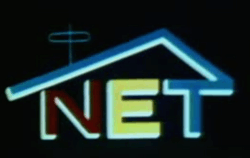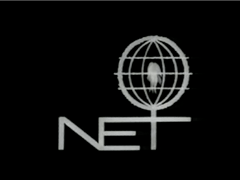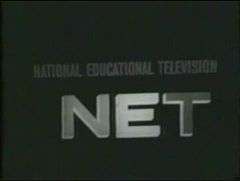National Educational Television
 | |
| Country | United States |
|---|---|
| Founded | November 1952 |
| Slogan | "This is NET" |
Broadcast area | United States and Canada |
| Owner |
Ford Foundation (1954–1970) Corporation for Public Broadcasting (1967–1970) |
Launch date | May 16, 1954 (as a network) |
| Dissolved | October 4, 1970 |
Former names |
Educational Television and Radio Center National Educational Television and Radio Center |
| Replaced by | PBS |
.jpg)
National Educational Television (NET) was a United States educational broadcast television network that was owned by the Ford Foundation and later co-owned by the Corporation for Public Broadcasting. Operating from May 16, 1954 to October 4, 1970, its direct successor, the Public Broadcasting Service (PBS), continues in operation and has memberships with many television stations that were formerly part of NET.
History

The network was founded as the Educational Television and Radio Center (ETRC) in November 1952 by a grant from the Ford Foundation's Fund for Adult Education. It was originally a limited service for exchanging and distributing educational television programs produced by local television stations to other stations; it did not produce any material by itself.[1]
In the spring of 1954, ETRC moved its operations to Ann Arbor, Michigan, and on May 16 of that year it began operating as a "network". It put together a daily five-hour package of television programs, distributing them primarily on kinescope film to the affiliated stations by mail.[2] The programming was noted for treating subjects in depth, including hour-long interviews with people of literary and historical importance. The programming was also noted for being dry and academic, with little consideration given to entertainment value, a marked contrast to commercial television. Many of the shows were designed as adult education, and ETRC was nicknamed the "University of the Air"[3] (or, less kindly, "The Bicycle Network", both for its low budget and for the way NET supposedly sent programs to its affiliates, by distributing its program films and videotapes via non-electronic means such as by mail, termed in the television industry as "bicycling").
The center's headquarters moved from Ann Arbor to New York City in 1958, and the organization became known as the National Educational Television and Radio Center (NETRC).[1] The center became more aggressive at this time, aiming to ascend to the role of the U.S.' fourth television network. Among its efforts, the network began importing programs from the BBC into the United States, starting with An Age of Kings in 1961.[4] It increased its programming output to ten hours a week.[1]
_-_NARA_cropped.jpg) | |
|
Eleanor Roosevelt, chair of the Presidential Commission on the Status of Women, interviews President John F. Kennedy, Secretary of Labor Arthur Goldberg and others, Open Vault from WGBH[5] |
The organization changed tactics again in November 1963. It renamed itself National Educational Television, and spun off its radio assets. Under the centerpiece program NET Journal, NET began to air controversial, hard-hitting documentaries that explored numerous social issues of the day such as poverty and racism. While praised by critics, many affiliates, especially those in politically and culturally conservative markets, objected to the perceived liberal slant of the programming.[6]
In 1966, NET's viability came into question when the Ford Foundation decided to begin withdrawing financial support because of NET's continual need for additional funding. In the meantime, the affiliated stations kept the network afloat by developing reliable sources of revenue. The U.S. government intervened and created the Corporation for Public Broadcasting in 1967 to fund the network for the time being. However, the CPB's intent was to create its own public broadcasting network. The CPB embarked on that course of action because many NET affiliates were alienated by the programming that the network offered. These affiliates further felt that NET's simultaneous production and distribution of programming constituted a conflict of interest.
Replacement by PBS

The Public Broadcasting Service (PBS) first began operations in 1969, with NET continuing to produce several programs. However, NET's refusal to stop producing and airing the critically acclaimed but controversial documentaries led to Ford and the CPB deciding to shut the network down. In early 1970, both threatened to cut their funding unless NET merged its operations with New York City-area affiliate WNDT (this did not, however, end the production and distribution of hard-hitting documentaries on public television, since PBS itself continues to distribute and CPB continues to help fund series including Frontline, POV and Independent Lens to this day).
On October 5, 1970, PBS officially began broadcasting after NET and WNDT completed their merger. NET ceased to operate as a separate network from that point, although some NET-branded programming, such as NET Journal, remained part of the PBS schedule for another couple of years before the brand was finally retired. WNDT's call sign was changed to WNET shortly afterward. Some programs that began their runs on NET, such as Washington Week and Sesame Street, continue to air on PBS today.
The NET acronym has since been revived twice, by unaffiliated companies: first in 1993 to 1997 as National Empowerment Television (later known as "America's Voice"), a cable channel that aired news and talk programming catering to a conservative audience; and in 2005, when Nebraska ETV and Nebraska Public Radio were united under a single name, Nebraska Educational Telecommunications of the Statewide network in Nebraska. In addition, the Japanese national television network TV Asahi was known as NET (Nihon Educational Television) from its inception until 1977.
See also
- PBS idents (includes IDs for NET)
- Public Broadcast Laboratory
- List of United States television networks
References
- 1 2 3 "National Educational Television (NET)". National Public Broadcasting Archives. Archived from the original on 22 August 2012. Retrieved 5 September 2013.
- ↑ "Ford Foundation Activities in Noncommercial Broadcasting, 1951-1976". Ford Foundation. 2009. Retrieved 2009-02-14.
- ↑ Carolyn N. Brooks (29 November 2007). "National Educational Television Center (NET)". Museum of Broadcast Communications. Retrieved 2008-12-30.
- ↑ An Age of Kings: an import becomes public TV’s first hit, David Stewart, Current, December 21, 1998
- ↑ "Prospects of Mankind with Eleanor Roosevelt; What Status For Women?". National Educational Television. Open Vault at WGBH. 1962. Retrieved September 19, 2016.
- ↑ "The Museum of Broadcast Communications - Encyclopedia of Television". Museum.tv. Retrieved 2016-07-13.
External links
- National Education Television Center on The Museum of Broadcast Communications
- Carolyn N. Brooks (29 November 2007). "National Educational Television Center (NET)". Museum of Broadcast Communications. Retrieved 2008-12-30.